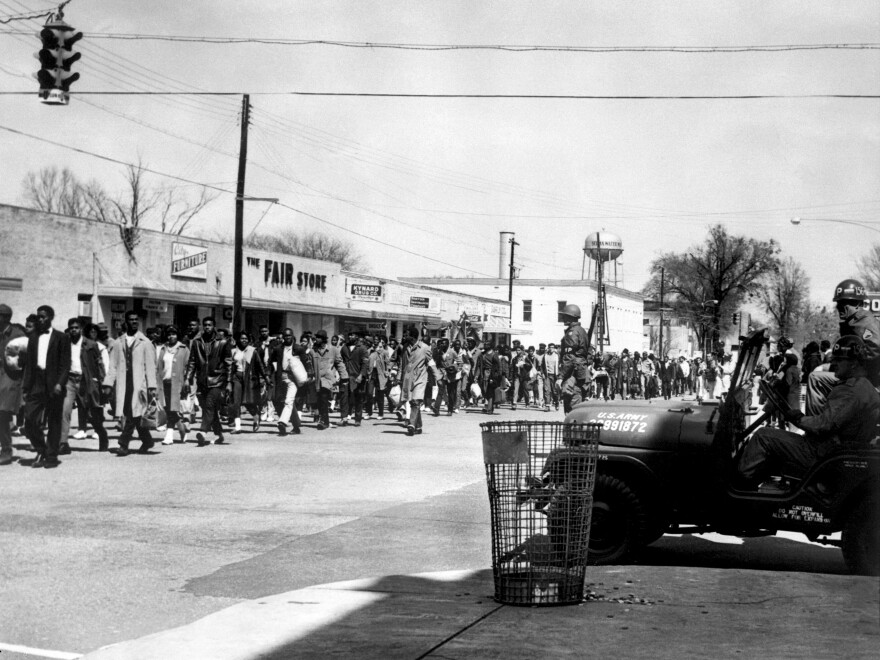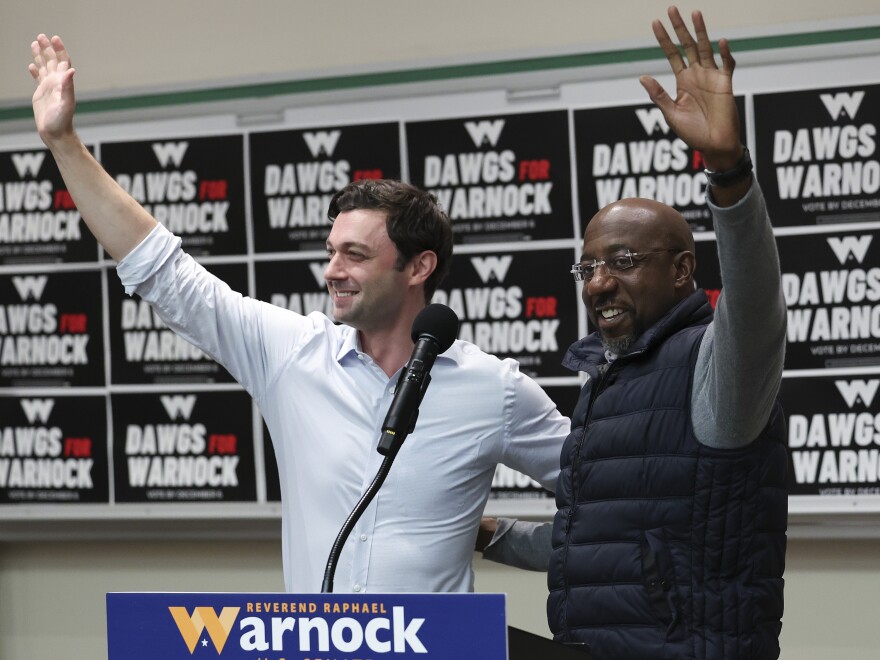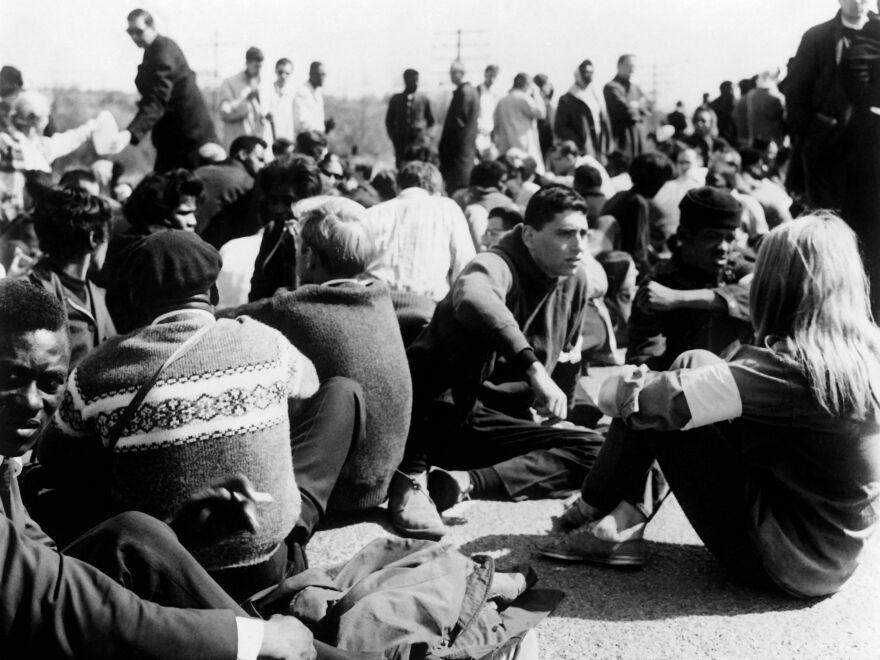Close your eyes and you might be able to conjure the iconic image of Rabbi Abraham Joshua Heschel, with a white bushy beard, as he marches alongside Reverend Dr. Martin Luther King, Jr. It's 1965 and they're at the front of the delegation from Selma to Mongtomery, Alabama. Everyone wears big Hawaiian leis – given as a symbol of support and solidarity by Reverend Abraham Akaka.
Scholars say this moment enshrines the so-called Grand Alliance, in which Black and Jewish leaders worked together in support of civil rights and voting rights.
After marching that day, Heschel said, "I felt my legs were praying."
And from the steps of the capitol in Montgomery, King said, "The end we seek is a society at peace with itself, a society that can live with its conscience. And that will be a day not of the white man, not of the black man. That will be the day of man as man."
Just a few months later, President Lyndon B. Johnson signed the Voting Rights Act of 1965.
So was this a major moment in the ongoing partnership between Black and Jewish leaders — or simply the high-water mark in a relationship that has long since receded?
"Today's Black Jewish relationship is encased in amber from the civil rights era, and I don't think it's properly understood," Jacques Berlinerblau, Professor of Jewish Civilization at Georgetown University, told NPR's Morning Edition. "And until we properly understand it, we might not be able to make sense of current political developments."
Berlinerblau has long studied the relationship between these two communities. He co-authored the book Blacks and Jews: an Invitation to Dialogue with Terrence Johnson, Professor of African American Religious Studies at Harvard Divinity School.

In speaking with NPR, Johnson defined the Grand Alliance as a group of elite African-American leaders working across racial religious lines to advocate for the masses in terms of voting rights and desegregation. And this sort of leadership went on to work with Jewish leaders with the founding of the NAACP in 1909 and the Urban League a year later."
"In some respects," Johnson continued, "those organizations represented the dream team of black and Jewish leaders, mostly men, unfortunately, but leaders nonetheless, who wanted to in many ways address the lingering problems of racial inequality and religious discrimination."
Johnson and Berlinerblau's book originated from a Georgetown University course they taught for years, engaging students in dialogue about the myriad ways that Black and Jewish Americans related to one another.
"It's an historic alliance because both groups have been demonized by what they can't control–a narrative of otherness," Johnson said. "And remember who was considered human in this country: Anglo-Americans. Jews were corrupted because of their blood and blacks were inferior because we didn't have a soul. And those fundamental issues are what we are haunted by now–what we hear with Black Lives Matter protests and related outcries around anti-Black racism and anti-Semitism."
And this relationship still looms large in the imagination of contemporary movement leaders. "There's no alliance more historic, nor more important, than the alliance between Black Americans and Jewish Americans," said Marc Morial, the president of the National Urban League in 2020.
A TROUBLED GRAND ALLIANCE: THEN & NOW
In a recent NY Times piece, Morial said the Grand Alliance is "being tested" by the Israel-Hamas war, with each group holding diverging views.
Recently, a group of more than 1,000 Black pastorsissued a demand that the Biden Administration push Israel to curb its military campaign. In a pressure campaign, the Black pastors say the support of their parishioners, key to Biden's reelection, could be on the line. And with Jewish Americans and Black Americans providing two key constituencies for Biden's reelection bid, this could be a tough needle to thread.
Reverend Leah Daughtry leads the House of the Lord Churches, a network of churches throughout the U.S. She was also CEO of the 2008 and 2016 Democratic National Convention committees. She recently told NPR that "we as faith leaders have to be concerned about the moral toll of this war and what our authority is. And what our responsibility is in ensuring that all people are safe, are able to live their lives in freedom and security, and that all children are able to grow and to live a thriving life."
Going even further, the African Methodist Episcopal Church, a well-known Black institution, recently called for the U.S. to "immediately withdraw all funding and other support from Israel." It goes on to allege that "the United States is supporting this mass genocide."
The Israel-Hamas War clearly represents a pivotal moment — but Johnson and Berlinerblau say diverging interests and perspectives have tested the Grand Alliance from the very beginning.
"The Grand Alliance was more fraught on the ground than is commonly understood," Berlinerblau said. "And it was probably a lot more wobbly than we would generally assume."
For example, their book examines persistent accusations made by some African Americans against Jewish Americans for their alleged involvement in the transatlantic slave trade. They cite historian Seymour Drescher, a noted expert on slavery and anti-slavery movements. In his essay entitled "Jews and New Christians in the Atlantic Slave Trade," Drescher found that "at no point along the continuum of the slave trade were Jews numerous enough, rich enough and powerful enough to affect significantly the structure and flow of the slave trade or to diminish the suffering of its African victims."
Nonetheless, such claims continue to resonate and reverberate, canonized by Nation of Islam leader Louis Farrakhan in his 1991 book The Secret Relationship between Blacks and Jews.
"Indeed, the Nation of Islam's worldview has pervaded Blacks and Jews for decades," Johnson and Berlinerblau write.
In fact, distrust between Black Americans and Jewish Americans created a sizable rift just a few years after Rabbi Abraham Joshua Heschel and Reverend Dr. Martin Luther King Jr. marched together for racial equality and civil rights.
According to Terrence Johnson, the shockwaves of 1967 can be felt even today.
That's the year of the Six-Day War between Israel and a coalition of Arab States. Many Black leaders began embracing the Palestinian and Arab cause, especially with Israel expanding its ties to the Apartheid government of South Africa.
Subsequent conflicts included the purging of white and Jewish members from the Student Nonviolent Coordinating Committee after the 1967 Arab-Israeli War;a teacher strike in New York City and the Crown Heights Riots in Brooklyn, both pitting Black and Jewish residents against one another–as well as ongoing disputes over affirmative action.

With ups and downs between the Black and Jewish communities over the years, and many misconceptions, Johnson and Berlinerblau say they wanted to emphasize discussion and mutual understanding in their teaching and writing.
They set out to co-write their book in part to update the 1995 text by Cornel West and Rabbi Michael Lerner called Jews and Blacks: A dialogue on Race, Religion, and Culture in America.
While assembling their own book, they both saw the rising support for Palestinian rights via the Black Lives Matter movement. They also witnessed a partnership hearkening back to the Grand Alliance — the 2020 victories of Georgia Senators Rafael Warnock and Jon Ossof which demonstrated a partnership between prominent Black and Jewish leaders.
Johnson and Berlinerblau write that this could be seen as "another turning point in the Black-Jewish civil rights coalition." But since they,along with other authors, argue that the Grand Alliance of the 1960s is romanticized and oversimplified, they instead call for new ways to seek mutual understanding and collaboration.
BRIDGING THE BLACK-JEWISH DIVIDE: ART & COLLABORATION
Many scholars and movement leaders find inspiration in the indelible artistic and cultural ties between the Black and Jewish communities.
"So one reason to hope that the relationship finds a new footing or moves forward in some dynamic way," Berlinerblau told NPR, "is the sheer awesome political, artistic, cultural intelligence of these two communities working in concert."
He cites such artistic examples as: Cannonball Adderley's jazz cover of "Fiddler on the Roof," Grace Paley's short story "Zagrowsky Tells," Anna Deavere Smith's performance piece "Fires in the Mirror," Spike Lee's BlacKkKlansman, and the Safdie brothers' film, Uncut Gems.
Johnson adds that a shared Old Testament notion of Zion appears frequently in hip hop music, epitomized by Lauryn Hill's song, "To Zion."
This famous Hebrew Bible story involving Moses leading the Israelites from bondage toward freedom shows the Harvard Divinity School professor a possible path forward for reunifying the Black and Jewish communities.
"Exodus and Zion keep recurring in hip hop, so there's something about the use of these stories that are so powerful and so beyond life that captures imagination and it becomes an entry point," Johnson told NPR.

"I was thinking of Abraham Heschel, who described this idea in 1963 of the Exodus is ongoing. And he said it was easier for the children of Israelites to cross the Red Sea than for a Black or Negro to cross the line at a university in the U.S.," Johnson said. "And there's something about this story that allows us to kind of peek into history and then figure out what's missing and whose voices are not there, even though they're very visible...and my sense is that the narratives will in some ways revive a moment that's much bigger than what we can imagine."
Berlinerblau and Johnson say that cultural and legal forces such as redlining and gentrification created physical distance between the Black and Jewish communities that were once more proximate.
"It doesn't mean they loved one another all the time," Berlinerblau said. "But they had a very, very organic, almost daily relationship with one another. And what Terence and I are increasingly seeing is that proximity, that physical proximity between African-Americans and Jewish Americans is kind of missing."
Some organizations doing this work of reconnection include: Rekindle, the Black/Jewish Justice Alliance, the Black Jewish Entertainment Alliance, and the Black and Jewish Leaders of Tomorrow. In many cases, art continues to reemerge as the bridge.
"The (Jewish) Federation in Baltimore recently had a yearlong exhibition around trauma in black and Jewish communities and used art as a way to invite people in to have these conversations," Johnson added. "So I think there are a lot of things happening on the ground. The issue becomes how did that get translated into a kind of political vocabulary that we can actually see structural change?"
Besides organizations and politicians with shared intentions, Johnson and Berlinerblau argue that reimagining Black-Jewish relations could best be accomplished by those who identify as both Black and Jewish.
Certainly, we can think of prominent celebrities such as Drake, Rashida Jones, Daveed Diggs, and Tiffany Haddish. But that's just the tip of the iceberg. In their book, the authors mention famous converts such as Sammy Davis Jr. and Nell Carter.
"We were extremely intrigued by the position of Afro Jews, Jews of color in the United States, of which we believe there may be more than half a million, if not more than that, in the country," Berlinerblau said. "But perhaps one way forward is to let this community, which physically or theologically or spiritually embodies a lot from both communities, maybe to let them lead...and to tell us where we all might move forward together."
Leah Donnella, who is Black and Jewish, is senior editor of NPR's Code Switch. And in a recent conversation, she reflected on her own upbringing. "My parents were very intentional about talking about those identities as being intertwined and related–and they did that very much through the lens of justice," Donnella said. "Fighting for justice has always been a tradition for both Black communities and Jewish communities. That's a lot of how both of my parents understood their faiths and their identities."
Outside of her own home, Donnella witnessed a major contrast. "Black people and Jewish people were not in the same spaces. There was not a lot of that overlap," Donnella said. "So that feeling of this identity being very integrated and very cohesive was not the demographic reality in the outside world."

While spending time in Jewish spaces, Donnella finds herself being asked to speak on behalf of Black people. And with inflamed passions on all sides since the October 7th attacks by Hamas, and the subsequent Israel-Hamas War, she says the divides aren't necessarily deepening; they're revealing what was already there.
"I think none of the reactions that different communities are having are that surprising to me," Donnella said. "But I think it's easy to feel surprised about some of the different reactions and takes if you are not interacting with a really diverse community of different people, both racially, demographically, and just on the political spectrum."
In terms of the legacy of the Grand Alliance, and the snapshots of Heschel and King, Donnella said it's not about connecting via racial or religious identity–but about shared beliefs, and how they're being pursued.
"For me, it comes back to that childhood thing of justice," Donnella said. "A lot of it is very central to the Jewish identity I was raised with, to be focused on the idea of Tikkun Olam, healing the world. And that's also really central to Black American identity."
But in terms of putting values into action, Donnella said the details are paramount. "It obviously gets tricky when you get really real about what justice means to you," she told NPR. "What does justice look like for everyone? And how do I help make that happen? And then you go from there–and then I think the connections happen organically, because people are after the same thing."
Copyright 2024 NPR. To see more, visit https://www.npr.org.



